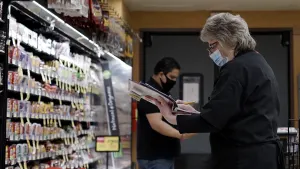More Stories
Grocery delivery is more popular than ever before as a result of the COVID-19 pandemic.
Consumers should be aware of fees when opting for grocery delivery.
Grocery delivery apps incorporate their fees in a few different ways:
Shopping lists: Charges for food can vary across apps for the same item, at the same store. Grocery store apps tend to get most of their fees by charging more for different items.
Delivery fees: These depend mainly on your total bill. Generally, the more you buy, the less the cost; however, this is not always the case, particularly if there are promotions. Many stores are charging standard delivery fees for orders over a certain amount and then a premium when less is purchased.
Fuel surcharge or service fees: Some apps, depending on your location and total delivery, may charge a fuel surcharge or service fee in addition to the delivery fee.
Pickup times: To save money on delivery fees, curbside pickup is offered at some stores. Pickup times closer to your order time may charge a premium.
Gratuity: A gratuity is typical for restaurant food delivery, and most grocery store delivery apps offer it as well. The requirements for tipping and the amount that goes to the driver can vary.
Here are some tips to help you save money when using grocery delivery apps:
1. Make a list
Food is one of the top national impulse purchases across all age groups and can contribute to 20% or more of a grocery bill. If you shop on the app with a list, the bill will likely be lower because you are not walking through the aisles.
2. Choose store pickup, next day
Curbside pickup allows consumers to save money on delivery fees, but some stores charge a premium to pick up your items close to your order time. Place your order a day before you need it, to keep fees down.
3. Shop around
If you are ordering food from one grocery store, see what the same order would cost you on another app or grocery store in the same area. Searching on “grocery delivery near me” is a good way to find out what stores and apps will deliver to your location.
4. Don't shop on multiple apps
Availability may vary, depending on the app, so consumers may have to look for those items elsewhere online. Consumers should be aware that shopping on multiple apps results in separate fees and delivery charges.
5. Confirm the gratuity policy
Often the grocery delivery people work as independent contractors and are not paid an hourly wage; instead receiving a per delivery stipend. Thus, the gratuity added is an important part of their income. Some delivery companies keep a portion of the gratuity charge rather than passing it on to the drivers in full. Check the app’s policy to understand what portion makes it to the driver – you may want to choose to cash tip the driver directly.
6. Become a member
Some grocery delivery apps are charging a fee and giving members additional promotions. Depending on the fee and the amount of actual deliveries a member utilizes, it may be beneficial for a frequent user to become a member. It is important to read all the terms and conditions for membership before signing up to ensure membership does not end up costing more over time.
7. Look at reviews
If you have never ordered from a grocery store before, check out reviews to see what to expect. Also check out the delivery services reviews in your area since delivery services are based on individual drivers and can vary greatly in different locations.
8. Check your order upon receipt
Stores may substitute items for more expensive alternatives. To save money, consumers should understand the store’s return policy and return the items to the store, if less expensive options are available.
9. Separate services, separate complaints
If there is a problem with your groceries, the delivery person is not necessarily connected with the grocery store. When you have an issue with your groceries, try contacting the grocery store first.
More from News 12
0:26

Want to support women-owned businesses? 5 ways to help you find shops during Women’s History Month

Buying a home? Here's a list of 6 things you should keep in mind during the process

Guide: 6 tips for making restaurant reservations
0:42

Guide: 7 Mother's Day gift ideas she will love
1:37

Budget: 9 ways to save money on your grocery bill
